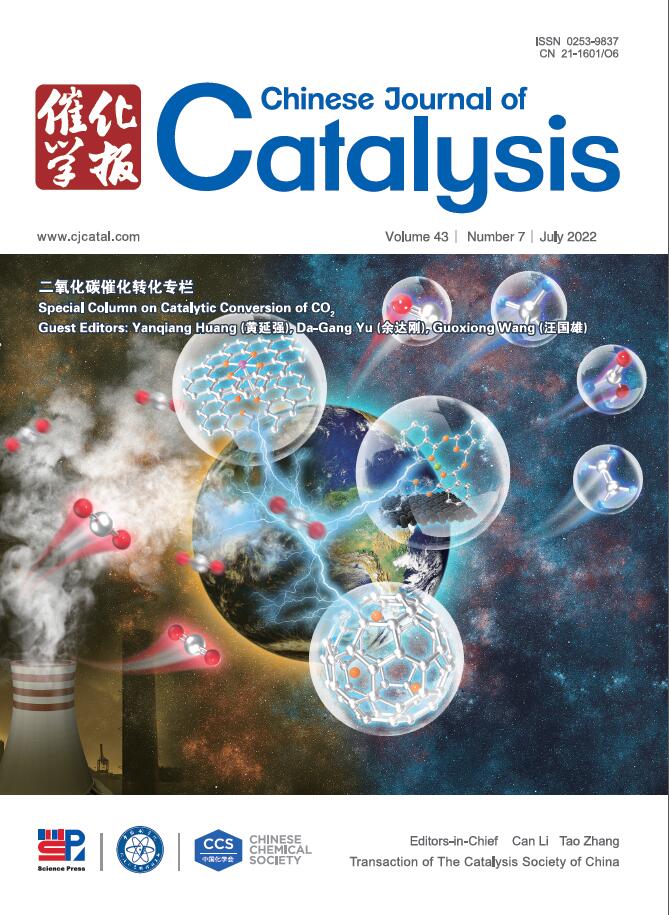Rational construction of S-scheme CdS quantum dots/In2O3 hollow nanotubes heterojunction for enhanced photocatalytic H2 evolution
IF 15.7
1区 化学
Q1 CHEMISTRY, APPLIED
引用次数: 0
Abstract
The rapid recombination of photogenerated carriers poses a significant limitation on the use of CdS quantum dots (QDs) in photocatalysis. Herein, the construction of a novel S-scheme heterojunction between cubic-phase CdS QDs and hollow nanotube In2O3 is successfully achieved using an electrostatic self-assembly method. Under visible light irradiation, all CdS-In₂O₃ composites exhibit higher hydrogen evolution efficiency compared to pure CdS QDs. Notably, the photocatalytic H2 evolution rate of the optimal CdS-7%In2O3 composite is determined to be 2258.59 μmol g−1 h−1, approximately 12.3 times higher than that of pure CdS. The cyclic test indicates that the CdS-In₂O₃ composite maintains considerable activity even after 5 cycles, indicating its excellent stability. In situ X-ray photoelectron spectroscopy and density functional theory calculations confirm that carrier migration in CdS-In2O3 composites adheres to a typical S-scheme heterojunction mechanism. Additionally, a series of characterizations demonstrate that the formation of S-scheme heterojunctions between In2O3 and CdS inhibits charge recombination and accelerates the separation and migration of photogenerated carriers in the CdS QDs, thus achieving enhanced photocatalytic performance. This work elucidates the pivotal role of S-scheme heterojunctions in photocatalytic H2 production and offers novel insights into the construction of effective composite photocatalysts.
S-scheme CdS量子点/In2O3空心纳米管异质结的合理构建促进光催化析氢
光生载流子的快速重组对CdS量子点在光催化中的应用造成了很大的限制。本文采用静电自组装方法,成功构建了三相CdS量子点与空心纳米管In2O3之间的新型S-scheme异质结。在可见光照射下,所有CdS- in₂O₃复合材料都比纯CdS量子点表现出更高的析氢效率。值得注意的是,最佳CdS-7% in2o3复合材料的光催化析氢速率为2258.59 μmol g−1 h−1,约为纯CdS的12.3倍。循环试验表明,CdS-In₂O₃复合材料即使经过5次循环也能保持相当大的活性,表明其具有良好的稳定性。原位x射线光电子能谱和密度泛函理论计算证实,CdS-In2O3复合材料中的载流子迁移遵循典型的s型异质结机制。此外,一系列表征表明,在In2O3和CdS之间形成S-scheme异质结抑制了电荷重组,加速了CdS量子点中光生载流子的分离和迁移,从而增强了光催化性能。这项工作阐明了s型异质结在光催化制氢中的关键作用,并为构建有效的复合光催化剂提供了新的见解。
本文章由计算机程序翻译,如有差异,请以英文原文为准。
求助全文
约1分钟内获得全文
求助全文
来源期刊

Chinese Journal of Catalysis
工程技术-工程:化工
CiteScore
25.80
自引率
10.30%
发文量
235
审稿时长
1.2 months
期刊介绍:
The journal covers a broad scope, encompassing new trends in catalysis for applications in energy production, environmental protection, and the preparation of materials, petroleum chemicals, and fine chemicals. It explores the scientific foundation for preparing and activating catalysts of commercial interest, emphasizing representative models.The focus includes spectroscopic methods for structural characterization, especially in situ techniques, as well as new theoretical methods with practical impact in catalysis and catalytic reactions.The journal delves into the relationship between homogeneous and heterogeneous catalysis and includes theoretical studies on the structure and reactivity of catalysts.Additionally, contributions on photocatalysis, biocatalysis, surface science, and catalysis-related chemical kinetics are welcomed.
 求助内容:
求助内容: 应助结果提醒方式:
应助结果提醒方式:


